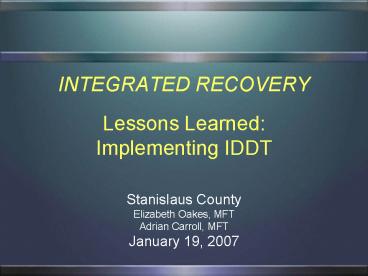INTEGRATED RECOVERY Lessons Learned: Implementing IDDT PowerPoint PPT Presentation
1 / 20
Title: INTEGRATED RECOVERY Lessons Learned: Implementing IDDT
1
INTEGRATED RECOVERYLessons Learned
Implementing IDDT
- Stanislaus County
- Elizabeth Oakes, MFT
- Adrian Carroll, MFT
- January 19, 2007
2
Organizational Context
- Why we selected IDDT
- -Committed to integrated services BHRS
- -Integrated system isnt integrated treatment
- -Established experience with co-occurring Tx
- -Valued EBP aspect
- -Interested in implementation aspect
- -Not the Money
- -High mortality rate
3
Organizational Context
- Why we selected IDDT continued
- -High co-morbidity
- -High treatment failure rate
- -Cost of not serving for system
- -Highly underserved
- -Co-occurring conditions often used as
exclusion criteria, rather than inclusion
criteria
4
Organizational Context
- Goals and expectations
- -Actual OP treatment track, consistent across
programs, across department - -Both broad system-wide competence
- and specialized enhanced expertise.
- -ID system barriers to implementing EBPs
- -Save money eventually
- -Accurate identification of AOD,MH, and COD
- -Develop staff training curriculum
- -Increased integration
5
Key Factors
- Factors that facilitated implementation
- -Staff with MH and AOD knowledge
- -CIMH training
- -Effective use of project planning consultant
- -Inter-county collaboration
- -Learning collaborative
- -System-wide steering committee
- -Psychiatrists early adopters
- -Integrated system
- -Training coordinator
6
Key Factors
- Factors that impeded implementation
- -Caseload size
- -Attempting treatment before engagement
- -MH downsizing and loss of funding
- -Resistance from some staff
- -Stigma, 2 types MH and AOD
- -Lack of COD housing
- -Funding categorical
7
Team Structure
- Project Team - Behavioral Health Integration
Oversight Committee - -Assistant Director
- -Chiefs and other key managers
- -Selected site Program Coordinators
- -Program Coordinators MH and AOD
- -Residential AOD manager
- -Training Coordinator
- -Line staff
- -MHSA Coordinator
8
Team Structure
- Clinical/IDDT Team
- -Program Coordinator
- -Psychiatrist
- -Consumer
- -Select MH Case managers
- -Select MH Clinicians
- -Select AOD counselors
9
Benefits of Integrated Recovery
- Saves money
- Helps staff motivation
- Impacts long-time stuck clients
- Stage-based treatment
- Formulation helps consumers understand how 2
conditions creates a 3rd condition - Recovering peers from either MH or AOD can
support each other - DRA sustained
- Recognition with in AOD for need of specialized
track
10
Team Structure
11
Sustaining Positive Change
- Challenges
- -Staff changes
- -Caseload size
- -Drift
- -Integration into daily practices
- -Forms
- -Staff passion for MH or AOD
- -Separate funding
12
Sustaining Positive Change
- Successes
- -Hire consumers with COD recovery
- -Paperwork to forms committee
- -All FSPs trained
- -Written into MHSA plan
- -Residential AOD with COD track
- -Stages of Treatment
- -MH and AOD specific stages
- -MH board member trained
13
(No Transcript)
14
(No Transcript)
15
(No Transcript)
16
SUPPORT WHEEL
Phone Numbers
Use In A Circular Manner So Not To Burn Out Any
One Source
My Recovery
Be Selective In Choosing Support Phone Numbers
17
(No Transcript)
18
Sustaining Positive Change
- Failures
- -Caseload size
- -Growing own experts
- -Motivational Interviewing measure
- -Didnt do own cost-benefit data
- -Greater consumer/family presence on steering
committee
19
Summary of Lessons Learned
- What we would do again
- -We would do it again
- -All of it
- -Stage-based, Motivational Interviewing, AOD
staff, clinical tools
20
Summary of Lessons Learned
- What we would do differently
- -Someone dedicated full time to implementation
- -More MI up front
- -More training for MH staff on state-of-art AOD
treatment

